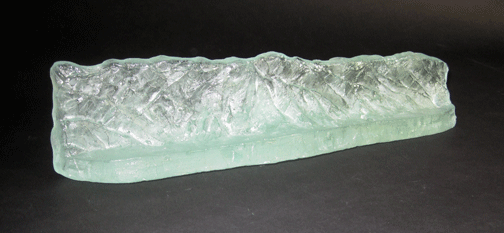|
Hello !
I hope you are still interested in hearing from me. If not, click here: Unsubscribe Me; and you will be promptly removed! (but I hope you don't)
Using plaster in fusing and casting
I generally keep two types of plaster on hand in the studio, Pottery Plaster and Plaster of Paris. Although both kinds of plaster are made with the same ingredients, I like to use them for different things.
Plaster for Glass Fusing
Plaster of Paris: This plaster is easily found at the hardware store and is quite inexpensive. The particle size is larger and more coarse than Pottery Plaster so it doesn't pick up superfine details as well. Plaster of Paris breaks down easily at full fuse temperatures, which makes it a good choice for plaster inclusions in fusing:

The plaster of paris inclusions can be easily removed after fusing.
Plaster in Glass Casting
For larger casting projects I prefer to user pottery plaster mixed with silica flour (both available from the local pottery supply place). The Pottery plaster is milled finer than Plaster of Paris so it picks up details better AND seems to survive fusing temperatures better. The silica flour increases the heat tolerance of your plaster and is quite important for casting.

If you have a different product or recipe that you don't mind sharing, let me know and I'll put together a list.
Thanks for reading!
Other announcements and stuff:
Fused Animal Pattern Books
The first batch of fused glass animal e-book is available on the website, and the Tree pattern is FREE!
Wholesale/bulk discount purchasing application for artists, stores and distributors is now online. Read more about it here.
|
|
Add Me To Your Address Book (please).

To make sure that you receive all email messages consistently in your inbox with images displayed, please add my address to your address book or contacts list: Jodi@GlassWithapast.com.
|
|
Have Any Questions?

Don't hesitate to hit the reply button to any of the messages you receive.
|
|
|

